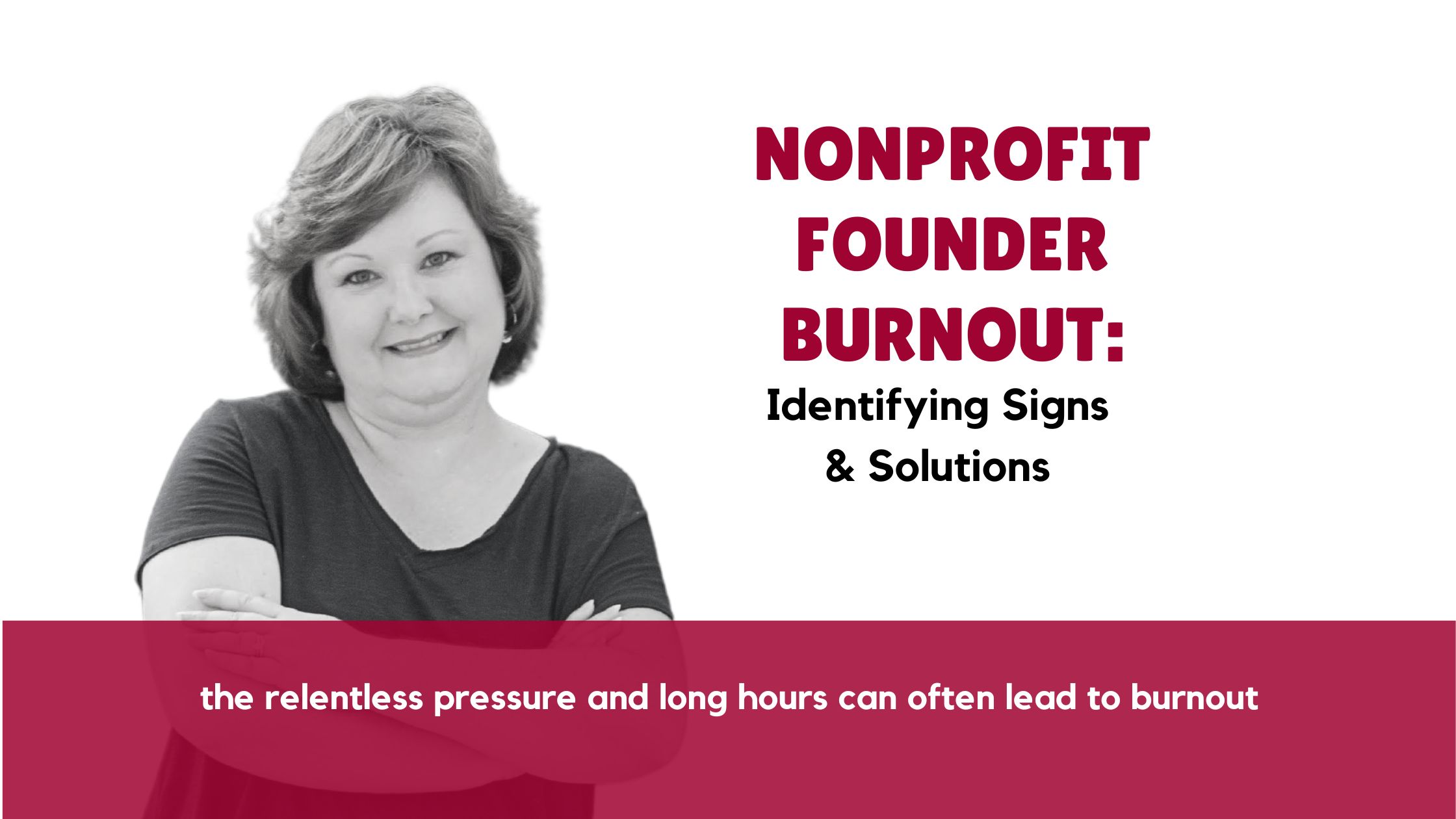Nonprofit Founder Burnout: Signs & Solutions
Nonprofit organizations play a vital role in addressing social issues, advocating for change, and making a positive impact on communities. The work of nonprofit professionals is undeniably inspiring, driven by the desire to create a better world. However, the nonprofit sector has challenges, and the relentless pressure and long hours can often lead to burnout. In this blog, we will explore the signs of nonprofit burnout, the unique challenges nonprofit professionals face, and proactive strategies to prevent burnout and prioritize self-care.
The Reality of Nonprofit Work
Nonprofit work is undoubtedly rewarding, but it also comes with its fair share of challenges. Unlike the corporate world, where the bottom line is profit, nonprofit organizations focus on social impact and making a difference in the world. This commitment to a greater cause often means nonprofit employees work long hours, sacrificing personal time and mental health for the sake of their mission.
The Inspiring yet Exhausting World of Nonprofit
Working in the nonprofit sector can be incredibly inspiring, as employees have the unique opportunity to work towards social change and support causes they deeply believe in. However, the workload in the nonprofit world is often demanding, leading to exhaustion and burnout. Nonprofit professionals work tirelessly, driven by the desire to serve constituents, but this dedication can take a toll on their mental health.
Challenges Facing Nonprofit Professionals
Nonprofit employees face a multitude of challenges that contribute to burnout. Relentless fundraising pressure, lack of management support, low salaries, and the emotional strain of the issues organizations address all impact the mental health of nonprofit professionals. High turnover rates within the sector can be attributed, in part, to burnout and exhaustion among nonprofit employees.
Unveiling the Silent Struggle of Burnout in Nonprofits
While burnout is a prevalent issue in many industries, it often remains a secret struggle within the nonprofit sector. Nonprofit professionals, driven by the pressure to appear dedicated, passionate, and committed, may feel the need to hide their burnout, fearing the impact it may have on the organization. Additionally, burnout is often seen as a personal failing rather than a systemic issue within the nonprofit world.
Why Burnout is a Secret in the Nonprofit Sector
The nonprofit sector emphasizing making a difference, can create an environment where burnout is hidden. There is pressure to maintain the image of dedication, passion, and selflessness, making it challenging for nonprofit employees to admit to burnout. Furthermore, nonprofit executives may fear the potential consequences of acknowledging burnout, worrying that it may reflect poorly on the organization or jeopardize fundraising efforts.
The Strength in Acknowledging Burnout
Acknowledging burnout is the first step towards addressing the issue in the nonprofit sector. By opening up about burnout, nonprofit employees can find support, resources, and understanding from their colleagues, friends, and loved ones. Recognizing burnout as a common experience within the nonprofit world can help reduce the stigma surrounding mental health issues, leading to a healthier work environment.
Spotting the Signs of Burnout
Burnout is a prevalent issue among nonprofit professionals, and it is critical to recognize its warning signs to address the problem before it spirals out of control. Identifying these indicators can help employees proactively prevent burnout and safeguard their mental health. Some common signs of burnout include chronic exhaustion, decreased productivity, cynicism or negativity towards work, and physical symptoms such as headaches or muscle tension. It is essential for both organizations and individuals to prioritize mental health and well-being to promote a healthy work environment. This can be done by implementing policies encouraging work-life balance, providing resources for stress management and mental health support, and promoting open communication between employees and management.
Common Indicators of Burnout
Burnout is a prevalent issue among nonprofit professionals, and it’s important to recognize common signs of burnout. Feeling overwhelmed and unable to keep up with the job’s demands, as well as losing energy and enthusiasm for work, are all indications of burnout. Burnout can also cause increased cynicism, detachment from work, decreased productivity, lack of motivation, and physical symptoms such as headaches, exhaustion, or changes in appetite. It is essential to take proactive steps to prevent burnout by taking breaks when needed, setting boundaries on workload, and seeking support from colleagues or mental health professionals if necessary. Additionally, prioritizing self-care activities like exercise or meditation can help alleviate stress and prevent burnout. Recognizing the signs of burnout early on can help prevent it from escalating into more severe problems that could affect one’s professional and personal life.
Proactive Measures Against Burnout
To prevent burnout, nonprofit employees should prioritize self-care and mental health support. This includes setting boundaries, both personal and professional, to create a work-life balance. Building strong support networks, both within the nonprofit sector and outside, can also help combat burnout. Implementing work-life balance policies, encouraging time off, leadership development programs, and cultivating a positive work culture are essential strategies organizations can employ to support the mental health of nonprofit employees.
Understanding the Unique Challenges Contributing to Burnout
To effectively address burnout in the nonprofit sector, it is crucial to understand the unique challenges that contribute to the issue. High expectations, limited resources, the emotional strain of social causes, weak boards of directors, relentless fundraising pressure, planned departures, low salaries, and lack of management support all play a role in the burnout experienced by nonprofit professionals.
High Expectations and Limited Resources
Nonprofit organizations often face the pressure of high expectations with limited resources, leading to employee burnout. Nonprofit professionals work tirelessly to make an impact, but the lack of funding, time, and support can be overwhelming. To combat burnout, nonprofit employees should focus on setting realistic goals, delegating tasks, and seeking support from colleagues and mentors.
The Emotional Strain from Social Causes
Working in the nonprofit sector means employees are often exposed to social issues that can be emotionally challenging. The emotional toll of dealing with these issues, combined with the high expectations of making a difference, can contribute to burnout. Setting boundaries, seeking support from colleagues and mentors, and prioritizing self-care are vital strategies for nonprofit professionals to prevent burnout and foster their mental well-being.
Strategies for Prevention and Self-Care
Preventing burnout and prioritizing self-care is crucial for the long-term well-being of nonprofit employees. By implementing proactive strategies, nonprofit professionals can sustain their passion, commitment, and mental health, enabling them to continue making a positive impact.
Setting Boundaries and Seeking Support
Establishing clear boundaries between work and personal life is essential to prevent burnout. Nonprofit employees should communicate their needs and limitations to team members and stakeholders, empowering others to support them. Delegating tasks, seeking support from mentors, coaches, or leadership development programs, regularly evaluating workloads, and making necessary adjustments are all proactive measures employees can take to prevent burnout.
How to Reignite Passion for the Mission?
Burnout can sometimes dampen the passion nonprofit employees have for their mission. To reignite the flame, employees can reflect on the organization’s mission, the impact of their work, and the constituents they serve. Attending conferences, workshops, or events that provide new perspectives and insights, collaborating with other nonprofit organizations, and fostering a culture of appreciation, recognition, and celebration of the team’s hard work can also help reignite the passion for the mission.
Are You Prioritizing Your Well-being as a Nonprofit Leader?
Nonprofit leaders, especially founders, have a responsibility not only towards the organization but also towards their personal well-being. It is crucial for nonprofit leaders to assess their personal well-being regularly, prioritize self-care, seek support from mentors, coaches, or leadership development programs, set realistic expectations, and establish boundaries to prevent burnout. Remember, personal well-being is the foundation for sustaining long-term impact in the nonprofit sector.
Conclusion
In conclusion, nonprofit work is undeniably inspiring and impactful, but it comes with its own set of challenges. Burnout is a silent struggle that many nonprofit professionals face due to high expectations, limited resources, and emotional strain from dealing with social causes. It is crucial for nonprofit founders to recognize the signs of burnout and take proactive measures to prioritize their well-being. This includes setting boundaries, seeking support, and finding ways to reignite their passion for the mission. Remember, your mental and physical health is as important as your work. Take care of yourself so that you can continue making a difference in the lives of others. Read or download the free ebook, “Burnout: The Secret Among Nonprofit Professionals” below.
What causes nonprofit founder burnout?
A combination of factors, including heavy workloads, long hours, limited resources, high levels of stress, and lack of support can cause nonprofit founder burnout. Additionally, the emotional investment in the cause and the pressure to achieve results can contribute to burnout among nonprofit founders.
In conclusion, nonprofit work is undeniably inspiring and impactful, but it comes with its own set of challenges. Burnout is a silent struggle that many nonprofit professionals face due to high expectations, limited resources, and emotional strain from dealing with social causes. It is crucial for nonprofit founders to recognize the signs of burnout and take proactive measures to prioritize their well-being. This includes setting boundaries, seeking support, and finding ways to reignite their passion for the mission. Remember, your mental and physical health are just as important as your work. Take care of yourself so that you can continue making a difference in the lives of others.

